#Royal Tyrrell Museum dinosaur finds
Photo

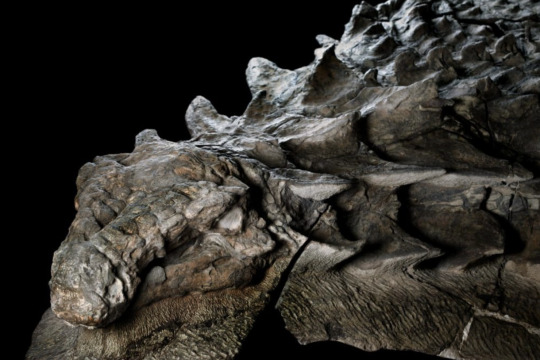
Discovered in a mine in Alberta, Canada in 2011, a fossil of a nodosaur dinosaur is one of the most well-preserved fossils of its kind, down to its skin, scales and even the contents of its stomach. These heavily-armored herbivores walked the Earth between the Late Jurassic and Late Cretaceous periods, with this particular specimen dating back 110 million years.
Considered one of the major archeological finds from the last decade, the nodosaur is currently on display at the Royal Tyrrell Museum in Alberta, Canada
#nodosaur#dinosaurs#dinosaur fossil#major archaeological find#dinosaur fossils#Royal Tyrrell Museum dinosaur finds#dinosaur museum in Alberta#Canada#archeology#archeological discoveries#mummified dinosaur
290 notes
·
View notes
Text
An incredibly rare discovery: a complete hadrosaur skeleton.
The fossil is of the large, plant-eating, duck-billed species was found sticking out of a hillside at Dinosaur Provincial Park in Alberta, Canada.
At the moment, all that’s visible of the fossil is a portion of the dinosaur’s tail and right hind leg, but researchers Brian Pickles of the University of Reading and Caleb Brown from the Royal Tyrrell Museum explained that the way in which the fossil is arranged suggests the skeleton is in a sitting position — and may be fully preserved within the hill.
According to Brown, roughly 400 to 500 dinosaur bones have been excavated from the area — but finding any fossils with skin is quite rare. Even rarer is finding a dinosaur preserved in the same position as they were in life.
1K notes
·
View notes
Text

First tyrannosaur fossil discovered with its last meal perfectly preserved in its stomach
Researchers have found a tyrannosaur’s last meal perfectly preserved inside its stomach cavity.
What was on the menu 75 million years ago? The hind legs of two baby dinosaurs, according to new research on the fossil published Friday in the journal Science Advances.
Dinosaur guts and hard evidence of their diets are rarely preserved in the fossil record, and it is the first time the stomach contents of a tyrannosaur have been uncovered.
The revelation makes this discovery particularly exciting, said co-lead author Darla Zelenitsky, a paleontologist and associate professor at the University of Calgary in Alberta.
“Tyrannosaurs are these large predatory species that roamed Alberta, and North America, during the late Cretaceous. These were the iconic apex or top predators that we’ve all seen in movies, books and museums. They walked on two legs (and) had very short arms,” Zelenitsky said.
“It was a cousin of T. rex, which came later in time, 68 to 66 million years ago. T. rex is the biggest of the tyrannosaurs, Gorgosaurus was a little bit smaller, maybe full grown would have been 9, 10 meters (33 feet).”
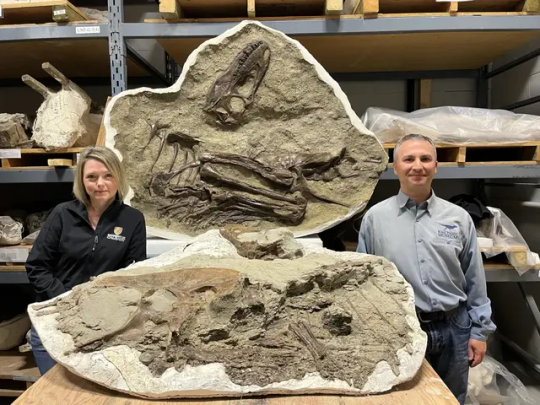
The tyrannosaur in question, a young Gorgosaurus libratus, would have weighed about 772 pounds (350 kilograms) — less than a horse — and reached 13 feet (4 meters) in length at the time of death.
The creature was between the ages of 5 and 7 and appeared to be picky in what it consumed, Zelenitsky said.
“Its last and second-to-last meal were these little birdlike dinosaurs, Citipes, and the tyrannosaur actually only ate the hind limbs of each of these prey items. There’s really no other skeletal remains of these predators within the stomach cavity. It’s just the hind legs.
“It must have killed … both of these Citipes at different times and then ripped off the hind legs and ate those and left the rest of the carcasses,” she added. “Obviously this teenager had an appetite for drumsticks.”

The two baby dinosaurs both belonged to the species called Citipes elegans and would have been younger than 1 year old when the tyrannosaur hunted them down, the researchers determined.
The almost complete skeleton was found in Alberta’s Dinosaur Provincial Park in 2009.
That the tyrannosaur’s stomach contents were preserved wasn’t immediately obvious, but staff at the Royal Tyrrell Museum in Drumheller, Alberta, noticed small protruding bones when preparing the fossil in the lab and removed a rock within its rib cage to take a closer look.
“Lo and behold, the complete hind legs of two baby dinosaurs, both under a year old, were present in its stomach,” said co-lead author François Therrien, the museum’s curator of dinosaur paleoecology, in a statement.
The paleontologists were able to determine the ages of both the predator and its prey by analyzing thin slices sampled from the fossilized bones.
“There’s growth marks like the rings of a tree. And we can essentially tell how old a dinosaur is from looking at those, the structure of the bone,” Zelenitsky said.
Changing appetites of top predators
The fossil is the first hard evidence of a long-suspected dietary pattern among large predatory dinosaurs, said paleoecologist Kat Schroeder, a postdoctoral researcher at Yale University’s department of Earth and planetary science, who wasn’t involved in the research.
The teen tyrannosaur didn’t eat what its parents did. Paleontologists believe its diet would have changed over its life span.
“Large, robust tyrannosaurs like T. rex have bite forces strong enough to hit bone when eating, and so we know they bit into megaherbivores like Triceratops,” Schroeder said via email. “Juvenile tyrannosaurs can’t bite as deep, and therefore don’t leave such feeding traces.”
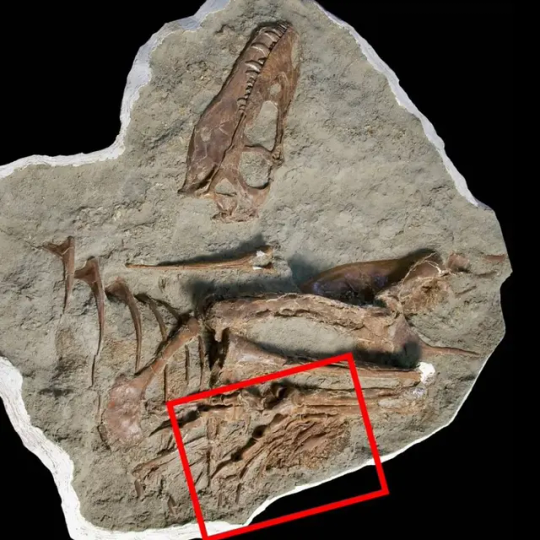
She said that scientists have previously hypothesized that young tyrannosaurs had different diets from fully developed adults, but the fossil find marks the first time researchers have direct evidence.
“Combined with the relative rarity of juvenile tyrannosaur skeletons, this fossil is very significant,” Schroeder added. “Teeth can only tell us so much about the diet of extinct animals, so finding stomach contents is like picking up the proverbial ‘smoking gun.’”
The contents of the tyrannosaur’s stomach cavity revealed that at this stage in life, juveniles were hunting swift, small prey. It was likely because the predator’s body wasn’t yet well-suited for bigger prey, Zelenitsky said.
“It’s well known that tyrannosaurs changed a lot during growth, from slender forms to these robust, bone-crushing dinosaurs, and we know that this change was related to feeding behavior.”
When the dinosaur died, its mass was only 10% of that of an adult Gorgosaurus, she said.
How juvenile tyrannosaurs filled a niche
The voracious appetite of teenage tyrannosaurs and other carnivores has been thought to explain a puzzling feature of dinosaur diversity.
There are relatively few small and midsize dinosaurs in the fossil record, particularly in the Mid- to Late Cretaceous Period — something paleontologists have determined is due to the hunting activities of young tyrannosaurs.
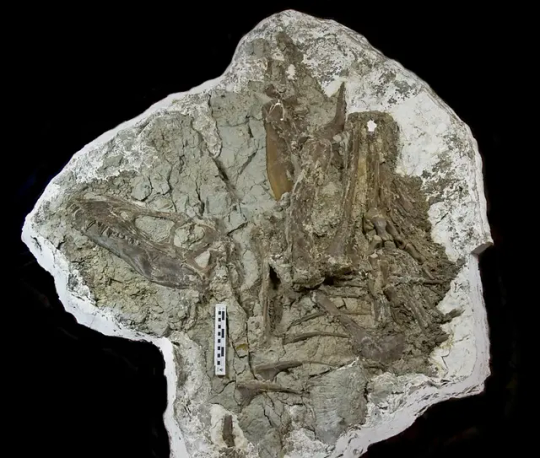
“In Alberta’s Dinosaur Provincial Park, where this specimen is from, we have a very well sampled formation. And so we have a pretty good idea of the ecosystem there. Over 50 species of dinosaurs,” Zelenitsky said.
“We are missing mid-sized … predators from that ecosystem. So yeah, there’s been the hypothesis that, the juvenile tyrannosaurs filled that niche.”
By Katie Hunt.


#First tyrannosaur fossil discovered with its last meal perfectly preserved in its stomach#tyrannosaur#Gorgosaurus libratus#Citipes#Citipes elegans#dinosaurs#paleontologist#Alberta’s Dinosaur Provincial Park#archeology#archeolgst#history#history news#ancient history
77 notes
·
View notes
Text
@just-late-roman-republic-things seems to be plowing through Suetonius Augustus and I am here for it!
Your mention of the dinosaur bones that Augustus used as home decoration reminds me of a story about Tiberius! (I swear, everything recently has been reminding me about Tiberius!)
By the way, finding the ancient source for this story was shit! I remembered reading this like a year ago, and I had forgotten which ancient source this was from. Using my critical thinking skills ("hmmm tiberius hmmmm dinosaur"), I assumed that this story came from Pliny's Natural History.
It did not.
I was searching through the Natural History for so long that I was starting to wonder if I had made the story up!
After searching through the Natural History for ages, I finally used more critical thinking skill and was like "Hmmm. Maybe if I google this, I could find an article about the event and maybe possibly it would cite a specific part of the Natural History!"
I googled it, found an article about the event, and it cited Phlegon's Book of Marvels.
Whoopsie! I was looking through the wrong book this whole time! In my defense, Pliny and Phlegon actually are pretty similar names if you squint sooo...
(it was however worth it to look through the Natural History because I found the funniest story about Tiberius ever but that's a story for another day)
Now that I have the ancient source of this story, I can finally tell it!
Basically, there was an earthquake which opened up all sorts of cracks on the ground. And in those cracks, there were dinosaur bones!
The people were pretty spooked so they took a tooth and sent it to Rome. And this was a massive tooth.
The tooth was showed to Tiberius and he was asked if he wanted the rest of the bones. He was like "Well, I'm really curious about this thing, and I'm aching to get an idea of what size it was, but it feels like graverobbing to take the rest of the bones."
So Tiberius got some dude called Pulcher who was skilled in geometry. Tiberius asked him to make a face in proportion to the tooth. The dude estimated the size of the creature using its tooth as a reference and then showed Tiberius a construction of it he had made. Tiberius said that looking at the construction was good enough and sent the tooth back where it came from.
Tiberius and (especially) Pulcher, the world's first paleontologists!
I love this story. It's wild. Though I do wonder what happened to the construction. Did Tiberius keep it?
If Tiberius randomly showed up at my door one day, I'd bring him to Drumheller to go to the Royal Tyrrell Museum. Alberta is one of the most boring places in the world but we do have a banging dinosaur museum!
On the hours-long drive there, I will most certainly give him like a billion questions, though. "How was Caligula like? How was Augustus like? How were you like? How was Livia like? How was Sejanus like? Actually, scratch this. Name every single person you know and tell me how they were like and how they looked like. What did you do in Capri? Explain your entire life from beginning to end, giving extra attention to the personal parts! I don't want to hear about wars I want to hear about what people were like! Could you read Suetonius to me and point out parts where he's wrong? Could we watch Domina together and you can tell me if you like your characterization or not?"
For everyone's sake, it's good that dead Roman emperors usually don't randomly show up sometimes (not counting whatever the fuck was happening right after Nero died!)
If you want to read the Tiberius Tooth sTory (haha Triple T) for yourself, you can here. Look for §13.
#ancient rome#roman history#ancient history#history#tiberius#emperor tiberius#dinosaur#dinosaurs#phlegon#phlegon book of marvels#pliny the elder#paleontology
38 notes
·
View notes
Text
Borealopelta markmitchelli found its way back into the sunlight in 2017, millions of years after it had died. This armored dinosaur is so magnificently preserved that we can see what it looked like in life. Almost the entire animal—the skin, the armor that coats its skin, the spikes along its side, most of its body and feet, even its face—survived fossilization. It is, according to Dr. Donald Henderson, curator of dinosaurs at the Royal Tyrrell Museum, a one-in-a-billion find.
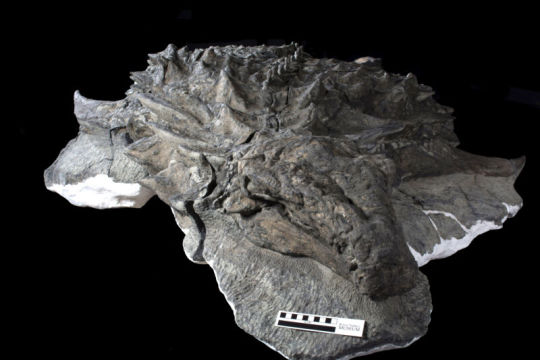
6 notes
·
View notes
Text
The oldest Cretaceous plesiosaur fossil ever at Syncrude's Mildred Lake Mine site. The discovery was made on March 12 by a hydraulic shovel operator.
Jenna Plamondon, a 16-year employee, spotted a contrast in the oil sand during her shift that day. I kept staring at this little chunk of dirt. As a shovel operator, out of the ordinary, Plamondon said in a statement on the website.
“I called my leader and asked to have geology look and confirm. We shovel just in case it was an actual fossil.” The geology team reached out to the Royal Tyrrell Museum upon the fossil.
After some examination, experts determined the fossil was part of a plesiosaur tail. Plesiosaurs, which are marine reptiles, lived about 115 million years ago.
Mildred Lake Mine Site would have been a vast shallow sea. Experts say similar fossils are usually found in rock layers higher up. They believe the creature may have died inland and washed up in the shallow water.
“This one may have been buried in a storm, which put a great deal of sand on top of the carcass all at once. This presents very unusual preservation conditions,” Dr. Donald Henderson, curator of dinosaurs to become fossils, such as marine reptiles and dinosaurs only that we’re shifting so much rock here, that we’re fortunate to see this small piece of fossil.”
Experts checked the area around the original site for additional fossil fragments, and after hours of searching, a piece of vertebrae was found by a geology co-op student.
“As we were digging, I found something similar to bone,” said Ruachwaar Gatwech, who is in his third year of geological studies at the University of British Columbia. “The senior geologist thought it would be a good experience for another co-op student to the site. It was quite an experience. It’s my first time in the mine to see and find an actual fossil in the field.”
The museum transported the fossil to Drumheller using a technique similar to casting a human bone. Experts say this ensured the protection of the fragile bone.
“I’m really excited because if the fossil ends up being displayed at the museum, I’ll get to show my one-year-old son what mom found,” Plamondon said. “Not every shovel operator gets to find one, so it’s pretty cool that I’m one of the few.”
0 notes
Text
Royal Tyrrell Museum In Drumheller Alberta
The post Royal Tyrrell Museum In Drumheller Alberta appeared first on Gr8 Travel Tips. This Content Originally Appeared On And Is Copyright Protected By The Author at https://ift.tt/UuGKgOE
Post Last Modified – February 12, 2023 ¦ gr8traveltips.com The Royal Tyrrell Museum Of Palaeontology In Drumheller Come see real exhibits of prehistoric creatures that once roamed the land millions of years ago, at the 🦕 Tyrrell Dinosaur Museum in 🌹 Drumheller, Alberta – 🍁 Canada. This beautiful museum is situated in the {Canadian Badlands,} of the Province of Alberta. A magnificent museum displaying some of the world’s most precious findings of – 🦖 Dinosaurs ever found! Royal Tyrrell Museum is located on the very land where these […]
The post Royal Tyrrell Museum In Drumheller Alberta appeared first on Gr8 Travel Tips. You Can Find The Original Post at https://ift.tt/UuGKgOE
from Royal Tyrrell Museum In Drumheller Alberta
Source:
0 notes
Text
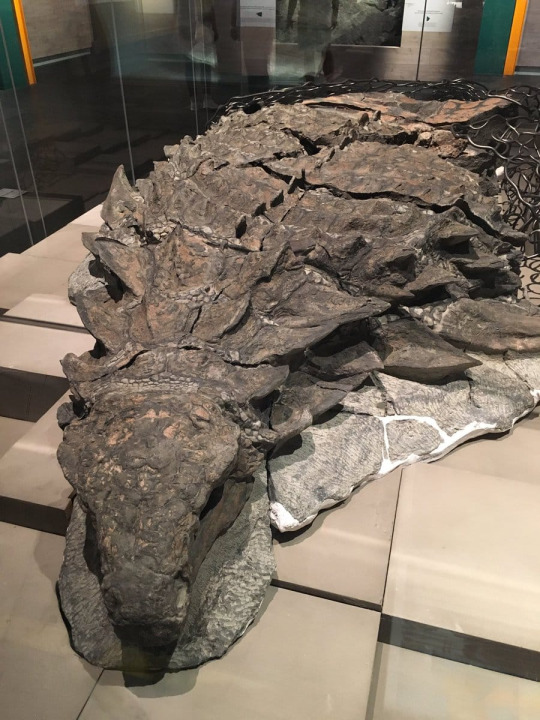
This fossilized nodosaur is more than 110 million years old, yet patterns are still visible on the skin. According to the Royal Tyrrell Museum of Paleontology in Alberta, Canada, which recently unveiled the find in 2017, the dinosaur is so well-preserved that instead of a fossil, we could safely call it a dinosaur mummy
0 notes
Text
JPI: 2001-2016
The formation of the Jurassic Park Institute represents the next step in the evolution of one of the most popular franchises in motion picture history - Jurassic Park. A science-based and educationally focused program, JPI has one mission - to provide kids, families, educators and scientists with the ultimate resource for dinosaur learning and fun.
Beginning with the launch of JPI Online, the Institute will, when completed, combine all forms of media to create the most exciting and dynamic forum for dinosaur fun, study, and research the world has ever known.
While Jurassic Park and Jurassic Park: The Lost World are works of fiction, the premise is grounded in scientific fact and theory. The filmmakers and author Michael Crichton went to great lengths to make sure that that the science upon which the movies were based was as credible and realistic as possible. The Jurassic Park Institute will use this as its foundation and will continue this commitment to authenticity.
Dinosaurs were the most spectacular and some of the most successful animals ever to walk the Earth. Often times they are a child's first entry into the world of science and a subject of endless fascination and speculation among people of all ages. By its unprecedented support of scientific research, its public communication of the latest information in science education, its activities, exhibits and programs, The Jurassic Park Institute opens a new window into the greatest adventure in the history of life - the world of dinosaurs.
Welcome to Jurassic Park Institute!
Jurassic Park Institute has one mission - to provide kids, families, educators and scientists with the ultimate resource for dinosaur learning and fun. We have invited renowned paleontologists, authors, educators, dinosaur experts and enthusiasts to participate in developing accurate scientific information, innovative activities, and thoughtful editorials to encourage the further exploration of knowledge on the subject of dinosaurs.
It is our goal to provide you with the most up to date information from around the globe regarding research, findings and discoveries. We our proud to present our outstanding content contributors for the Jurassic Park Institute web site.
Established in 1997 by Universal Studios and Amblin Entertainment, the Jurassic Foundation has funded dozens of paleontological research projects. Focusing on smaller, field research projects, the Foundation has contributed in excess of $1 million to the scientific community - making it one of the largest private funders of dinosaur research in the world.
The Jurassic Foundation is run by dinosaur scientists for dinosaur scientists. It is presently chaired by Dr. Philip Currie of the Royal Tyrrell Museum of Palaeontology in Drumheller, Alberta with fellow board members, Dr. John R. "Jack" Horner, Jurassic Park science advisor and professor of paleontology at the Montana State University in Bozeman, Montana and Dr. Kathy Forster of the State University of New York at Stony Brook.
The Jurassic Foundation board awards grants via applications from fellow scientists with priority on support of graduate and international researchers. The Foundation has operated, since its inception, entirely without any overhead or administration costs - 100% of its revenues have gone to grants and endowment for future grants.
Welcome to the Jurassic Park Institute Dino Guides. Here you will be able to browse the database to find the newest Jurassic Park products; locate links to some of the best dinosaur sites on the web; and you will even be able to locate dinosaurs in your local area with the museum and park resources. It's all here, so just click on the section you want and you're off to worlds not seen in 65 million years!
JPI: DINOSAUR FIELD GUIDE
Written by two noted paleontologists, this kid-friendly nonfiction book uses easy-to-understand text to describe at least 100 dinosaurs alphabetically. More
JPI: DINOSAUR STICKER BOOK
When kids enter the Jurassic Park Institute DINOSAUR STICKER BOOK they'll discover 50 re-usable dinosaurs stickers that are ready to stomp and roar through 16 full-color pages of jungle backdrops and fun activities. More
JPI: DINOSAURS ALIVE! STICKER BOOK
This oversized sticker book is packed with reusable dinosaur stickers, colorful backdrops, and fascinating dino facts! A great interactive companion to our DINOSAURS ALIVE!
More
DINOSAURS ALIVE! The Dinosaur-Bird Connection (Step 4, Step-into-Reading Book)
- Are birds the descendants of dinosaurs? Many scientists believe dinosaurs are still alive among us--in the shape of our fine-feathered friends! More
1 note
·
View note
Text
Malignant bone cancer has been diagnosed in a dinosaur for the first time ever
https://sciencespies.com/nature/malignant-bone-cancer-has-been-diagnosed-in-a-dinosaur-for-the-first-time-ever/
Malignant bone cancer has been diagnosed in a dinosaur for the first time ever
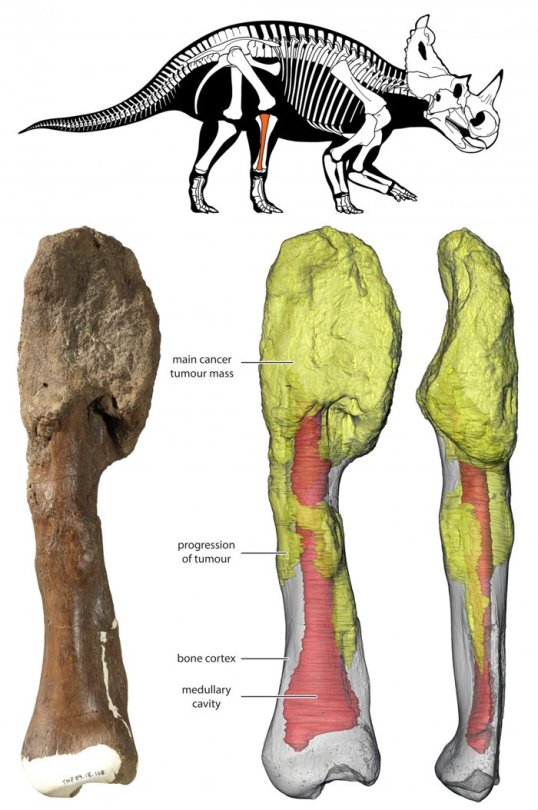
A palaeontologist, a medical pathologist, and an orthopaedic surgeon walk into a museum. No, it’s not the start of a joke, but the research team that has now diagnosed the first confirmed case of aggressive bone cancer in a dinosaur.
The specimen in question is a fossilised shin bone from Centrosaurus apertus, a plant-eating horned dinosaur that lived and died roughly 76 million years ago.
What looked – at least on first impression – like a poorly healed fracture turned out to be a tumour engrossing the upper half of the animal’s shin bone, or fibula. The centrosaurus was diagnosed with an osteosarcoma; it’s the most common type of bone cancer in humans, but marks the first confirmed case of any malignant cancer we’ve found in a dinosaur.
“Here, we show the unmistakable signature of advanced bone cancer in [a] 76-million-year-old horned dinosaur – the first of its kind,” said pathologist Mark Crowther. “It’s very exciting.”

The shin bone, with the main tumour mass in yellow. (Danielle Dufault/Royal Ontario Museum/McMaster University)
In humans, osteosarcomas often affect growth-spurting teenagers and young adults. If an osteosarcoma metastasises – grows beyond the bone – it most often spreads to the lungs, but can also form tumours in other bones, and even the brain.
However curious we are about the evolution of diseases such as cancer, soft tissues like tendons, ligaments, bone marrow and tumours, are rarely preserved in fossils. Given a few years – let alone a million – these tissues would decay. So even if dinosaurs were regularly struck down by cancer, any diagnostic samples are going to be hard to find.
Scientists have come across similar cancer-like symptoms on dinosaur fossils before. Unusual lesions in the tail vertebrae of a young hadrosaur resembled a condition called Langerhans cell histiocytosis, a complex cancer which leaves room for debate over its manifestation. In the case of this most recent discovery, the malignancy is far more clear.
The cancer-stricken fossilised shin bone of C. apertus was unearthed in Dinosaur Park Formation in Alberta, Canada back in 1989, and had been stored at the Royal Tyrrell Museum of Palaeontology, outside of Calgary, until its recent reanalysis.
Cross sections of the C. apertus bone were taken first with a CT scanner, the same machine used to identify bone fractures and tumours in people. The X-ray image ‘slices’ were reconstructed to see how the tumour grew through the fossilised bone.
In fact, it had spread through the bone quite extensively, which the team of medical specialists took as a sign that this centrosaur lived with its cancer for quite some time.
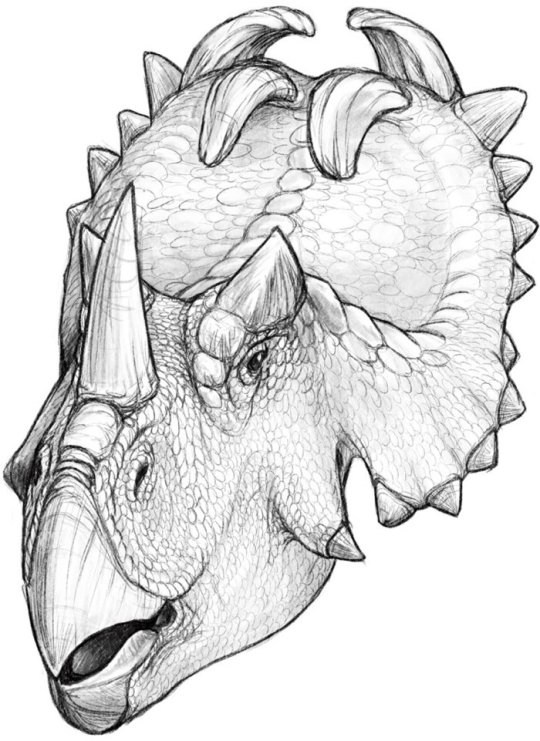
Artist’s impression of Centrosaurus apertus. (Royal Ontario Museum/McMaster University)
“This discovery reminds us of the common biological links throughout the animal kingdom and reinforces the theory that osteosarcoma tends to affect bones when and where they are growing most rapidly,” said Seper Ekhtiari, an orthopaedic surgeon-in-training at McMaster University in Toronto, who examined the fossil.
As the cancer was so advanced, the researchers think it might have spread to other parts of the dinosaur’s body, but we don’t have any of those tissue samples – such as the spongy lungs – from this ancient animal to make sure.
“The shin bone shows aggressive cancer at an advanced stage,” said paleontologist David Evans. “The cancer would have had crippling effects on the individual and made it very vulnerable to the formidable tyrannosaur predators of the time.”
After imaging the cancerous shin bone, thin sections were carefully sliced off the fossil and compared to a normal C. apertus fibula, along with one case of human osteosarcoma, from a 19-year-old man who had it in his lower leg.
In their paper, the authors note that ”a similarly advanced osteosarcoma in a human patient, left untreated, would certainly be fatal.”
But they suspect the dinosaur died with its herd mates, possibly in a sudden flood event, because the fossil was found in a massive bed of Centrosaurus bones.
“The fact that this plant-eating dinosaur lived in a large, protective herd may have allowed it to survive longer than it normally would have with such a devastating disease,” Evans said.
And when we often marvel at the age of dinosaurs and their size, big and small, this latest medical discovery brings the plight of the dinosaurs a little closer to home.
“Evidence suggests that malignancies, including bone cancers, are rooted quite deeply in the evolutionary history of organisms,” the authors concluded. Yes, even dinosaurs.
The study is published in medical journal The Lancet Oncology.
#Nature
2K notes
·
View notes
Note
if possible could you infodump about dinosaurs please and thank you
OUGH OK.
honestly one of my favourite things abt dinosaurs is just the LENGTHS palaeontologists go to to see things abt them yk. like generally it’s pretty rare for feathers to fossilize/get in amber n stuff yk, and it’s really cool what they can do to figure out where the feathers were located. for example, on the bones of modern birds, on the wings there are little bumps on the actual bone where the feathers meet the bone, and that tells us that there’s major feathers there, and there are plenty of dinosaur bones we’ve found that also have this on the legs/tail. they can also look at the habitat of the dinosaur, which is why some dinosaurs, like tyrannosaurus rex, don’t have feathers and others do. there are a lot of feather haters that say tyrannosaurus couldn’t have had feathers which is like… yeah. it didn’t. we have skin imprints of almost every part of the body that shows it had scales, but they didn’t need feathers, because they lived in temperate rainforests, and also they were *huge*. think elephant: for one, they already live in a hot environment, but their sheer size is a good enough insulator as is. same thing with tyrannosaurus. but there are other large tyrannosaurs that did have feathers, like nanuqsaurus, because they lived in arctic environments and they needed the extra insulation. another thing is the way they find out what colours some of the dinosaurs were: they literally look at fossilized cells. it’s a very rare thing, as it needs really specific types of rock and really specific circumstances to happen, but it does happen, and there’s a handful of dinosaurs that we do know the colour of! most of them are avian dinosaurs (like microraptor and caihong), but there’s two non-avians we’ve found as well (psittacosaurus and borealopelta)! i’ll go over a couple of them:
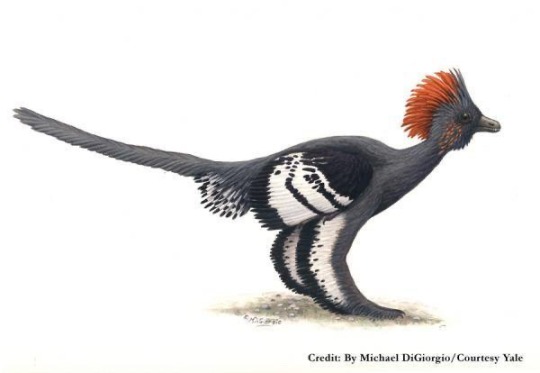
this is anchiornis! they’ve been found to have solid grey colouring on most of their bodies, but their wings had black and white barring, and they might have even been sexually dimorphic, as some specimens had red crests and others didn’t. i think this one is super cool for that reason <3

this is sinosauropteryx! they were a really small theropod, and they had bright orange feathers with a barred tail and a “mask” like a raccoon’s! it’s likely that their feathers were for display, as they weren’t suited for flight.
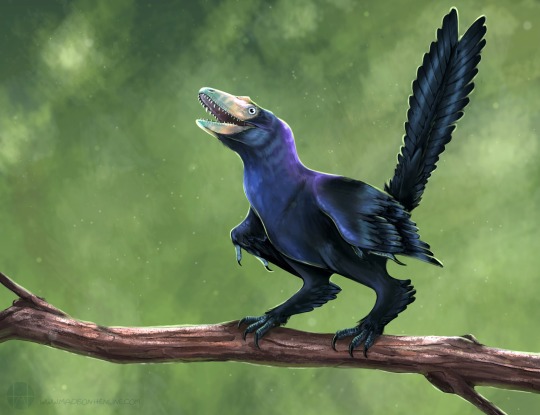
again, this is caihong, which was found to have mostly black feathers, but had some iridescent feathering on their neck and the fronts of their wings! they’re also one of the coolest ones to me for this reason
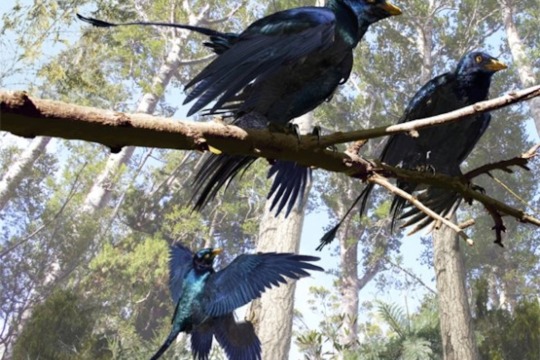
this is microraptor, which was about the size of a crow, and looked really similar, too, with their black/iridescent feathers.
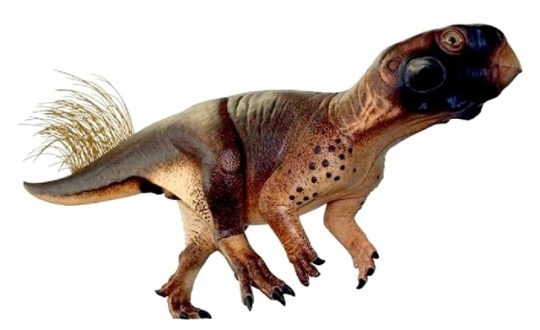
this is psittacosaurus, which looked super funky, with their dark masked faces, earthy colours, spots, and tail spines. they’re also a lot smaller than you’d think. i think they’re so weird and i love them
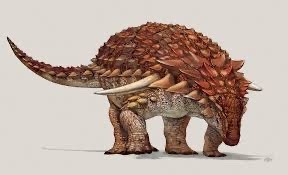
and this is borealopelta! it’s the only armoured dinosaur we know the colour of, and it was a reddish-brown, and it’s all thanks to this fantastic fossil right here, currently held at the royal tyrrell museum in drumheller, alberta, one of my bucket list places!
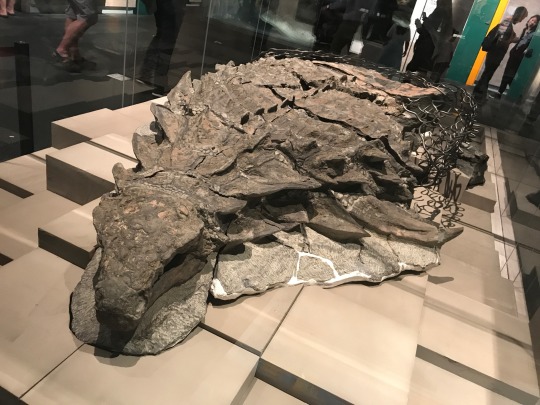
there’s plenty more but i’m tired and i don’t want this post to get too long lmao, but tysm anon ily <3
29 notes
·
View notes
Text
In 2008, paleontologist Phil Currie returned to a remote location in Mongolia to collect the skeleton of an ankylosaur he first came upon in 1999.
That specimen would give new insight into the armoured, almost tortoise-like dinosaur.
Currie, a professor at the University of Alberta and a founder the Royal Tyrrell Museum of Palaeontology in Drumheller, Alta., said the discovery revealed new information about the animal's limbs and also confirmed a theory presented in the 1970s about the ankylosaur's adaptation to digging.
Continue reading
28 notes
·
View notes
Text
The Bromacker Fossil Project Part XIII: What We Learned

Collage of the fossils highlighted in this series. Images not to scale. Photos by the author, Dave Berman, and Thomas Martens.
The Bromacker quarry is a rare site in that it preserves exquisite, articulated fossils of a unique vertebrate fauna that lived in an atypical or rarely recorded Early Permian (~290 million years ago) setting. Early in our work at the Bromacker, we became aware that the fossil vertebrates we were finding were unknown or extremely rare in Europe but were closely related or identical to species commonly found in North America. Until then, most of the fossil vertebrates found in Europe were discovered in gray to black sediments deposited in ancient lake beds, whereas the fossils from the Bromacker quarry occurred in red beds representing a terrestrial setting. Paleontologists looking for fossils in Europe typically prospected the gray to black sediments where fossils were relatively plentiful rather than red beds, which were thought to represent arid environments not conducive to fossil preservation.

Photograph of a diorama showing the Tambach Basin 290 million years ago, which was once exhibited at the Museum der Natur, Gotha. It was built in 1996, so many of the inhabitants of the basin weren’t yet discovered. One of these is Dimetrodon teutonis, which was inadvertently depicted as being large and numerous. Image provided by Thomas Martens, 2020.
In a collaborative effort to help determine how the fossil deposit at the Bromacker quarry formed and why its vertebrate fauna is unique, Dave Berman invited his colleague David Eberth to join us for the 1998 field season. David is a geologist/vertebrate paleontologist who was then employed by the Royal Tyrrell Museum of Palaeontology in Canada but is now retired. The sediments preserving the Bromacker fossils are part of a rock unit called the Tambach Formation and were deposited in the Tambach Basin. The results of David’s study, built in part upon investigations by other geologists and paleontologists, indicate that the Tambach Basin was situated within an ancient mountain range and isolated from river systems. At the time the fossils were deposited, the basin was internally drained, and as a result, when it rained, water would flow towards the basin center and form ephemeral ponds and lakes. Based on the geology, fossil plant assemblage, and geographic setting of the Tambach Basin, David concluded that the climate was possibly similar to the wet‑and‑dry tropical climate of modern North African savannas, Brazilian Campos, or the Venezuelan Llanos.
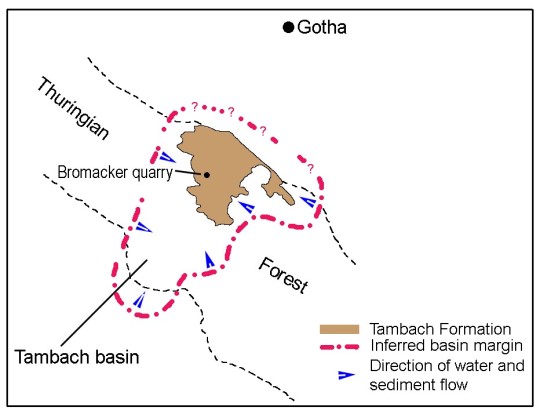
Map showing the areal extent of the Tambach Formation today and the inferred boundary of the Tambach Basin, with arrows indicating direction of water flow. The northern boundary of the basin is not preserved, but it was thought to have been closed when the Bromacker fossil deposit formed. Modified from Eberth et al., 1997.
Most of the fossils discovered at the Bromacker quarry came from two massive units, the more fossiliferous of which is about 21 inches thick, that formed in separate major flooding events. David theorized that these deposits formed when heavy rain caused a sheet-flood of sediment‑laden water to sweep down the sides of the Tambach Basin and across the basin floor, killing any animals that couldn’t escape the flow. The sheet-flood transported the carcasses to the basin center where they were deposited, rapidly buried, and eventually fossilized. These deposits record a unique snapshot of vertebrate life in the Tambach Basin, because only animals inhabiting the basin would have been captured by the sheet-flood.
In contrast, most Early Permian fossil‑bearing deposits in North America formed on coastal or alluvial plains. Carcasses would’ve been transported to the deposition sites by rivers, some of which had a large geographic reach. These types of deposits can accumulate over a long period of time and have potential to mix together fossils from different environments.

Photograph of a diorama once exhibited at Carnegie Museum of Natural History that shows a typical Early Permian peat swamp or backwater swamp of a major river system. A similar modern environment would be the Okefenokee Swamp, Georgia. Photo by Mindy McNaugher, 2007.
Besides having an atypical geographic setting, the makeup of the Bromacker vertebrate fauna differs from those known from other Early Permian sites. The Bromacker vertebrate fauna has a low diversity of terrestrial tetrapods, but more importantly, it lacks fishes and aquatic to semi‑aquatic constituents. This is probably due to the Tambach Basin’s isolation from regional river systems and because it experienced seasonal to sub‑seasonal drying, making it difficult for water-reliant vertebrates to become established. Based on numeric counts of individual specimens, we determined that the relatively large‑sized herbivores Diadectes, Orobates, and Martensius greatly outnumbered the synapsid apex predators Dimetrodon and Tambacarnifex. We think the rarity and low diversity of synapsid carnivores is probably due to the lack of an aquatic to semi‑aquatic component in the food chain.
In contrast, most Early Permian North American localities preserve a diverse, mixed aquatic‑terrestrial fauna that either lived in water or was closely associated with water and aquatic food chains. Herbivores were rare in terms of both diversity and numbers, whereas synapsid apex predators were diverse and numerous.

A more dynamic North American Early Permian scene that includes a mixed aquatic‑terrestrial vertebrate fauna. The Dimetrodon on the right has caught a freshwater shark, demonstrating the importance of aquatic animals in the food chain. © Julius Csotonyi/Houston Museum of Natural Science.
The Bromacker is the oldest known terrestrial vertebrate ecosystem in which herbivores greatly outnumber apex carnivores, and in that respect, it resembles terrestrial vertebrate ecosystems of today. A modern example is the African savanna in which large herds of herbivores such as zebra, wildebeest, and buffalo provide a food source for a much smaller number of carnivores including lions, cheetahs, and hyaenas. Indeed, we consider the Bromacker to represent an early stage in the development of the modern terrestrial vertebrate ecosystem and that these early stages were restricted to upland areas isolated from aquatic‑based food chains.
This summary concludes the Bromacker Fossil Project blog post series. I hope that you’ve enjoyed reading it. Cast replicas of many of the fossils described in this series are exhibited in the Fossil Frontiers display case in CMNH’s Dinosaurs in Their Time exhibition, so be sure to look for them on your next visit. I’m grateful to Dave Berman, Albert Kollar, Thomas Martens, and Stuart Sumida, who answered numerous questions and provided photographs, and to Patrick McShea and Matt Lamanna for their editing skills. Click here to read the paper by Eberth et al. 2000.
Amy Henrici is Collection Manager in the Section of Vertebrate Paleontology at Carnegie Museum of Natural History. Museum employees are encouraged to blog about their unique experiences and knowledge gained from working at the museum.
15 notes
·
View notes
Text
Nasutoceratops titusi

By Scott Reid
Etymology: Large-Nosed Horned-Face
First Described By: Sampson et al., 2013
Classification: Dinosauromorpha, Dinosauriformes, Dracohors, Dinosauria, Ornithischia, Genasauria, Neornithischia, Cerapoda, Marginocephalia, Ceratopsia, Neoceratopsia, Coronosauria, Ceratopsoidea, Ceratopsidae, Centrosaurinae, Nasutoceratopsini
Status: Extinct
Time and Place: Between 76 and 75.6 million years ago, in the Campanian age of the Late Cretaceous


Nasutoceratops is known from the middle member of the Kaiparowits Formation in Utah
Physical Description: Nasutoceratops is a Ceratopsian - so, as with all Ceratopsians, it has an extremely distinctive head! Like other Ceratopsians, it would have been around 5 meters long or so, and had a very bulky body with a short, skinny tail. The legs of this dinosaur - as in others of its kind - were short, bulky, and had very padded and thick toes that made running easy for this animal. The really distinctive aspects of this dinosaur, however, were in its head - again, as in other Ceratopsians, which might as well all be Mr. Potato Heads with the different combinations of horns and frills as the exchangeable parts of the classic toy. Nasutaceratops sported a short frill, a short and high snout, and distinctively long horns. The horns on its brow were more horizontal than most, but they curved inward like those found on modern cattle! The nostril did not feature a horn, but was very high and ridged instead. Interestingly enough, there were extensive cavities in this rounded nose that may have been pneumatic, giving Nasutoceratops a very unique trait compared to other Ceratopsians. It had a very thickly overlapping upper jaw, which would have made it somewhat less flexible than other Ceratopsians. The frill had small round osteoderms all around the edge, and there isn’t a notch on the frill like in other Ceratopsians. As in its relatives, Nasutoceratops would have probably been primarily scaly, though it may have had feather-quills on the edge of its tail or elsewhere on its body. The frill would have probably been brightly colored, for display.
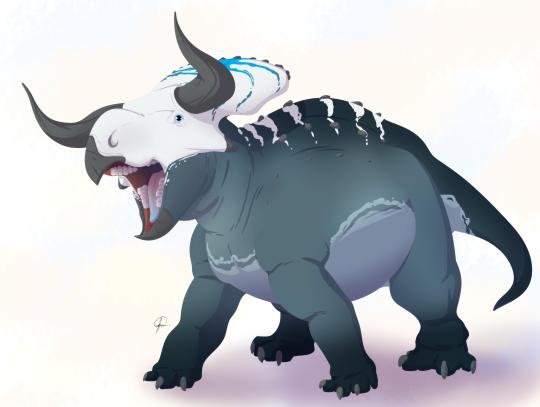
By José Carlos Cortés
Diet: Nasutoceratops would have primarily been an herbivore, feeding on low-lying and medium-level leaves and other plant material, all less than one meter tall.
Behavior: Nasutoceratops, like other Ceratopsians, would have been a very social creatures! These dinosaurs would have spent a lot of time together roaming their home in large herds, and used their frills and fancy horns to display to one another for communication and mating displays. This points back to their fairly complicated social groupings, where the young would have been protected by the adults from oncoming danger. The horns would have also been useful in telling apart Nasutaceratops from other dinosaurs that lived with it, such as the Chasmosaurine Ceratopsian Kosmoceratops. Like other dinosaurs, it would have been warm-blooded, and thus needed to spend a good chunk of the day finding food. It also may have fought with its horns, though that’s somewhat more controversial, especially given their odd shape - though a combination of the bumpy nose and horns . These horns may have had sheaths of fingernail material (keratin) over them, making them longer, but probably not more available for fighting. The colors of the frill may have been able to change, giving even more communication ability. These structures - the frills and horns - wouldn’t have been prominent in baby Nasutoceratops, but grew with the animal as it aged into sexual maturity. Nasutoceratops would have taken care of its young, which would eventually join the herd with the adults.
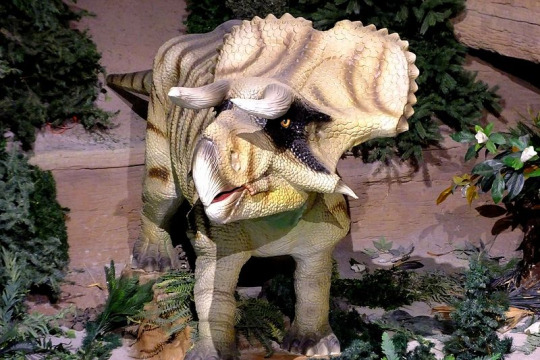
By Kathy Neenan, CC BY-SA 4.0
Ecosystem: Nasutoceratops lived in the Kaiparowits Formation, which would have been a very muddy jungle ecosystem, with a wide variety of animals living very near the Western Interior Seaway. A variety of swamps, ponds, and lakes frequented the entire area, which was surrounded on its other side by highlands and mountains, enclosing it against the sea. It was a very wet and humid environment, allowing for high animal diversity. Among those that lived with Nasutoceratops include other Ceratopsians like Kosmoceratops and Utahceratops, hadrosaurs like Gryposaurus and Parasaurolophus, the ankylosaur Akainacephalus, the Troodontid Talos, the Ornithomimid Ornithomimus, the Oviraptor Hagryphus, and the opposite bird Mirarce! That being said, the main predator of Nasutoceratops would definitely have been the local Tyrannosaur, Teratophoneus. There were also a variety of mammals, turtles, and Neosuchians in the environment, which all took advantage of the wet swampy conditions.

By Ripley Cook
Other: Nasutoceratops was a Centrosaurine, those Ceratopsians more closely related to the likes of Styracosaurus than to Triceratops. Interestingly enough, these Ceratopsians tend to do more weird stuff with their noses - usually giant horns, but Nasutoceratops seems to have gone for a more lightweight option. In fact, Nasutoceratops gave its name to a whole group of these animals, which retained the brow horns of the ancestral ceratopsians (where other Centrosaurines lost them).
~ By Meig Dickson
Sources Under the Cut
Atterholt, J.; J. Howard Hutchison; Jingmai K. O’Connor (2018). "The most complete enantiornithine from North America and a phylogenetic analysis of the Avisauridae". PeerJ. 6: e5910.
Chiba, K., M. J. Ryan, F. Fanti, M. A. Loewen. D. C. Evans. 2018. New material and systematic re-evaluation of Medusaceratops lokii (Dinosauria, Ceratopsidae) from the Judith River Formation (Campanian, Montana). Journal of Paleontology 92 (2): 272-288.
Eaton, Jeffrey G.; Cifelli, Richard L.; Hutchinson, J. Howard; Kirkland, James I.; Parrish, J. Michael (1999). "Cretaceous vertebrate faunas from the Kaiparowits Plateau, south-central Utah". In Gillete, David D. (ed.). Vertebrate Paleontology in Utah. Miscellaneous Publication 99-1. Salt Lake City: Utah Geological Survey. pp. 345–353.
Eaton, J.G., 2002. Multituberculate mammals from the Wahweap(Campanian, Aquilan) and Kaiparowits (Campanian, Judithian)formations, within and near Grand Staircase-Escalante NationalMonument, southern Utah. Miscellaneous Publication 02-4, UtahGeological Survey, 66 pp.
Fowler, D. W. 2017. Revised geochronology, correlation, and dinosaur stratigraphic ranges of the Santonian-Maastrichtian (Late Cretaceous) formations of the Western Interior of North America. PLoS ONE 12 (11): e0188426.
Getty, M. A., M. A. Loewen, E. M. Roberts, A. L. Titus, and S. D. Sampson. 2010. Taphonomy of horned dinosaurs (Ornithischia: Ceratopsidae) from the late Campanian Kaiparowits Formation, Grand Staircase-Escalante National Monument, Utah. In M. J. Ryan, B. J. Chinnery-Allgeier, D. A. Eberth (eds.), New Perspectives on Horned Dinosaurs: The Royal Tyrrell Museum Ceratopsian Symposium. Indiana University Press, Bloomington 478-494
Hone, D.W.E.; Naish, D.; Cuthill, I.C. (2011). “Does mutual sexual selection explain the evolution of head crests in pterosaurs and dinosaurs?” (PDF). Lethaia. 45 (2): 139–156.
Lund, E. K. (2010). "Nasutuceratops titusi, a new basal centrosaurine dinosaur (Ornithischia: Ceratopsidae) from the upper cretaceous Kaiparowits Formation, Southern Utah". Department of Geology and Geophysics University of Utah: 172 pp.
Mallon, Jordan C; David C Evans; Michael J Ryan; Jason S Anderson (2013). [tp://link.springer.com/article/10.1186/1472-6785-13-14 "Feeding height stratification among the herbivorous dinosaurs from the Dinosaur Park Formation (upper Campanian) of Alberta, Canada"]. BMC Ecology. 13: 14.
Roberts EM, Deino AL, Chan MA (2005) 40Ar/39Ar age of the Kaiparowits Formation, southern Utah, and correlation of contemporaneous Campanian strata and vertebrate faunas along the margin of the Western Interior Basin. Cretaceous Res 26: 307–318.
Roberts EM, Sampson SD, Deino AL, Bowring S, Buchwaldt R. The Kaiparowits Formation: a remarkable record of Late Cretaceous terrestrial environments, ecosystems and evolution in western North America. In: Titus AL, Loewen MA, editors. At the Top of the Grand Staircase: The Late Cretaceous of Southern Utah. Bloomington, Indiana: Indiana University Press; 2013. p. 85–106.
Ryan, M.J.; Holmes, R.; Mallon, J.; Loewen, M.; Evans, D.C. (2017). "A basal ceratopsid (Centrosaurinae: Nasutoceratopsini) from the Oldman Formation (Campanian) of Alberta, Canada". Canadian Journal of Earth Sciences. 54.
Sampson, S. D., 2001, Speculations on the socioecology of Ceratopsid dinosaurs (Orinthischia: Neoceratopsia): In: Mesozoic Vertebrate Life, edited by Tanke, D. H., and Carpenter, K., Indiana University Press, pp. 263–276.
Sampson, S. D., M. A. Loewen, A. A. Farke, E. M. Roberts, C. A. Forster, J. A. Smith, and A. L. Titus. 2010. New horned dinosaurs from Utah provide evidence for intracontinental dinosaur endemism. PLoS One 5(9):e12292:1-12.
Sampson, S. D.; Lund, E. K.; Loewen, M. A.; Farke, A. A.; Clayton, K. E. (2013). "A remarkable short-snouted horned dinosaur from the Late Cretaceous (late Campanian) of southern Laramidia". Proceedings of the Royal Society B: Biological Sciences. 280 (1766): 20131186.
Tanke, D.H. and Brett-Surman, M.K. 2001. Evidence of Hatchling and Nestling-Size Hadrosaurs (Reptilia:Ornithischia) from Dinosaur Provincial Park (Dinosaur Park Formation: Campanian), Alberta, Canada. pp. 206–218. In: Mesozoic Vertebrate Life—New Research Inspired by the Paleontology of Philip J. Currie. Edited by D.H. Tanke and K. Carpenter. Indiana University Press: Bloomington. xviii + 577 pp.
Titus, Alan L. and Mark A. Loewen (editors). At the Top of the Grand Staircase: The Late Cretaceous of Southern Utah. 2013. Indiana University Press. Hardbound: 634 pp.
Weishampel, David B.; Dodson, Peter; and Osmólska, Halszka (eds.): The Dinosauria, 2nd, Berkeley: University of California Press. 861 pp.
Wiersma, J. P.; Randall B. Irmis (2018). "A new southern Laramidian ankylosaurid, Akainacephalus johnsoni gen. et sp. nov., from the upper Campanian Kaiparowits Formation of southern Utah, USA". PeerJ. 6: e5016.
Zanno, Lindsay E.; Sampson, Scott D. (2005). "A new oviraptorosaur (Theropoda; Maniraptora) from the Late Cretaceous (Campanian) of Utah". Journal of Vertebrate Paleontology. 25 (4): 897–904.
Zanno, L.E., Weirsma, J.P., Loewen, M.A., Sampson, S.D. and Getty, M.A. (2010). A preliminary report on the theropod dinosaur fauna of the late Campanian Kaiparowits Formation, Grand Staircase-Escalante National Monument, Utah.[permanent dead link]" Learning from the Land Symposium: Geology and Paleontology. Washington, DC: Bureau of Land Management.
Zanno, L. E.; David J. Varricchio; Patrick M. O'Connor; Alan L. Titus; Michael J. Knell (2011). "A new troodontid theropod, Talos sampsoni gen. et sp. nov., from the Upper Cretaceous Western Interior Basin of North America". PLoS ONE. 6 (9): e24487.
#Nasutoceratops titusi#Nasutoceratops#Dinosaur#Ceratopsian#Palaeoblr#Factfile#Prehistoric Life#Mesozoic Monday#Herbivore#North America#Cretaceous#Paleontology#Prehistory#Dinosaurs#Dinosaur of the day#A Dinosaur A Day#A-Dinosaur-A-Day#Dinosaur-of-the-Day#nature#biology#science
313 notes
·
View notes
Text
A Trip to Drumheller.
If you ever get the chance to visit Alberta then you should definitely take a day to explore the Town of Drumheller. Considered to be the Dinosaur capital of the world, this little Town has so much to offer.
Some of those things include:
Royal Tyrrell Museum
Atlas Coal Mine: National Historic Site
Worlds Largest Dinosaur
Horsetheif Canon
The Hoodoos

One of the biggest attractions in this Town is their museum. The Royal Tyrrell Museum is a large, interactive museum dedicated to dinosaurs, which are rotated in and out of viewing. Keep in mind that although some of the museums interactive exhibits are closed due to the recent outbreak of Covid-19, there is still so much to see.
______________________________________________________________
So... if you ever find yourself in Alberta then make sure that you put “exploring Drumheller” on the top of your list.
#drumheller#alberta#southern alberta#fun#dinosaur#dinosaurs#museum#things to do#must see#amazing#worth it#worth the trip#bones#history#ancient#tourist attraction
8 notes
·
View notes
Text
When southern Alberta was a humid subtropical wetland 60 million years ago, two tiny primates lived in the Calgary area, possibly climbing through the ancient trees and plucking fruit with their fingers.
The two new species were identified from fossils taken from a handful of sites between Calgary and Cochrane, according to a new paper published this month in the Journal of Paleontology. The findings shed light on the diversity of ancient mammals following the extinction of the dinosaurs.
Craig Scott, the director of preservation and research at the Royal Tyrrell Museum in Drumheller, was a co-author of the study, which included researchers from around the world.
Edworthia greggi and Ignacius glenbowensis were ape-like prehistoric primates. They were small and resembled small lemurs, with long faces and eyes on the sides of their heads.
The new species was discovered by studying the morphology of fossil teeth — the enamel is the tough tissue. The new species was found in four locations exposed cut bank along West Nose Creek in northwest Calgary and a rail cut along the eastern edge of Cochrane.
Two other sites are along the north side of the Bow River between the two communities, including one in Glenbow Ranch Provincial Park — hence the name "glenbowensis" for one of the species.
According to Scott, the fossil record in Alberta displays an increasingly diverse range of prehistoric life, from dinosaurs to the archaic primates he helped name.
The discovery of these new species helps scientists fill in the gaps in their understanding of evolutionary history, particularly when it comes to early primates.
The two new species are thought to have lived during the Paleocene epoch, about 66 to 56 million years ago, after the mass extinction event that killed the dinosaurs.
One of the species, Edworthia Greggi, is thought to be slightly older than the other, Scott said, adding that the small primates would not have crossed paths in the ancient forests as they existed one after the other.
Both species belong to a group of prehistoric primates with a massive geographic range, travelling from the southern United States to the High Arctic. Like most branches in the evolutionary tree, this group eventually went extinct.
1 note
·
View note